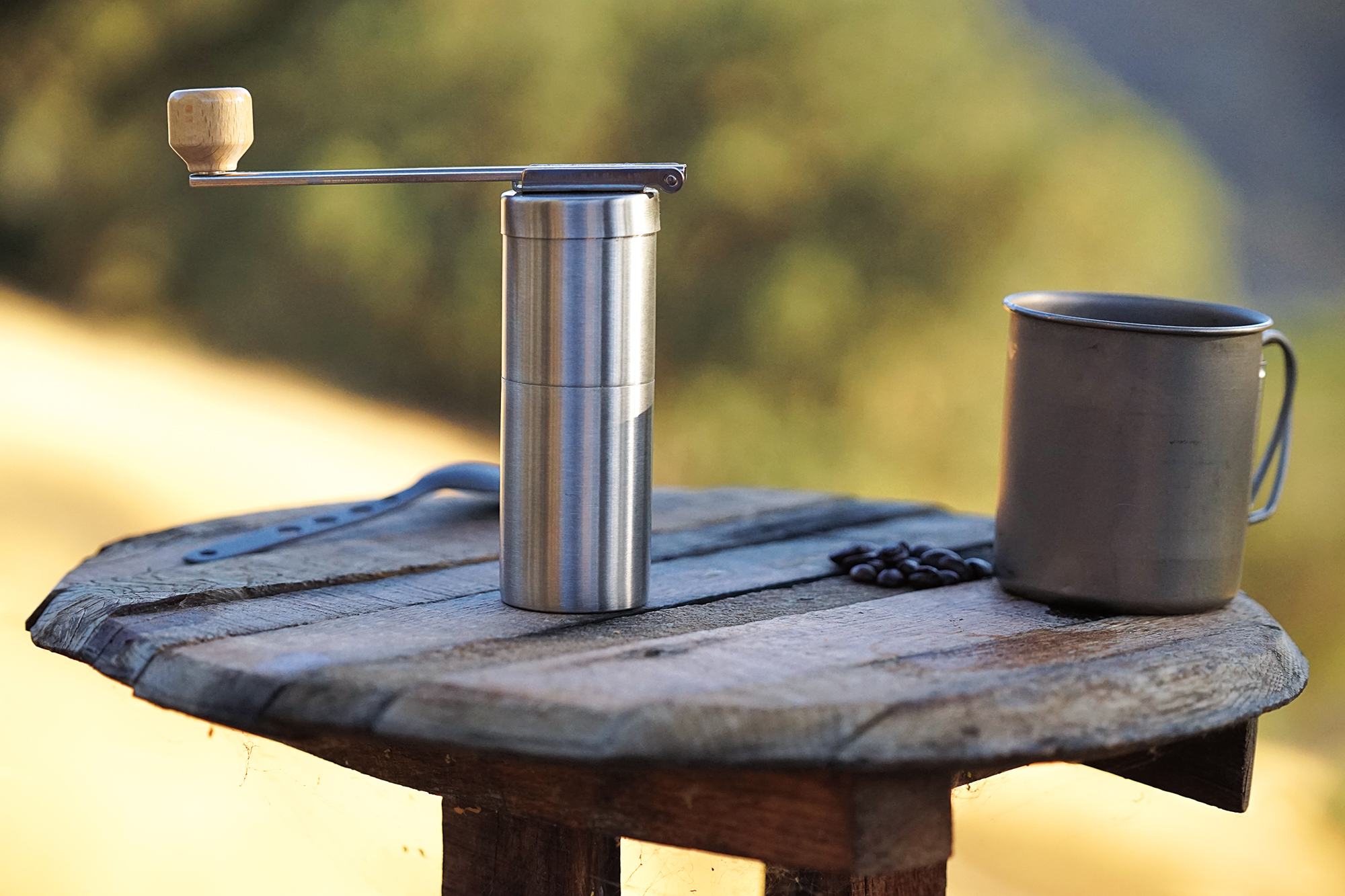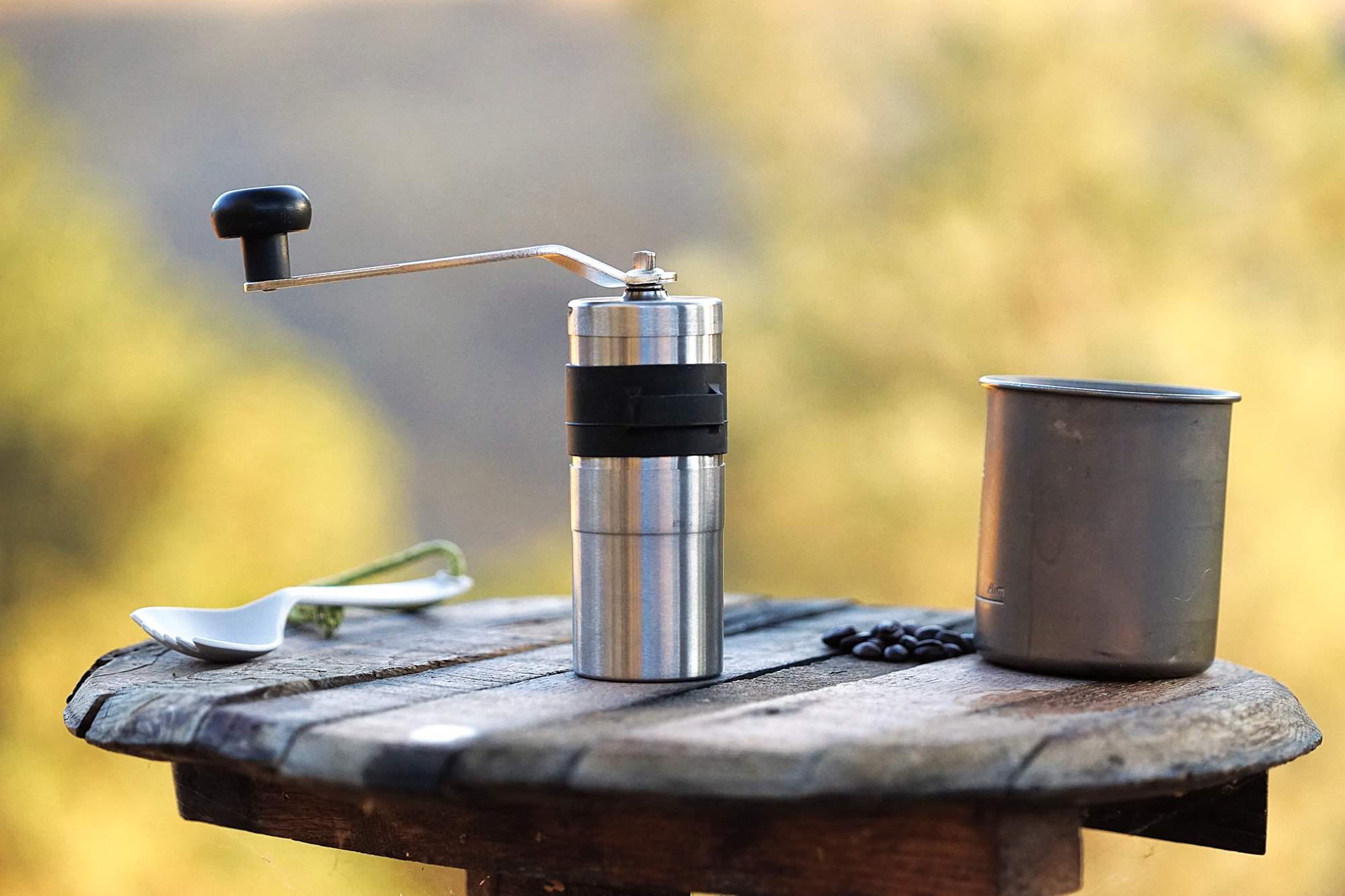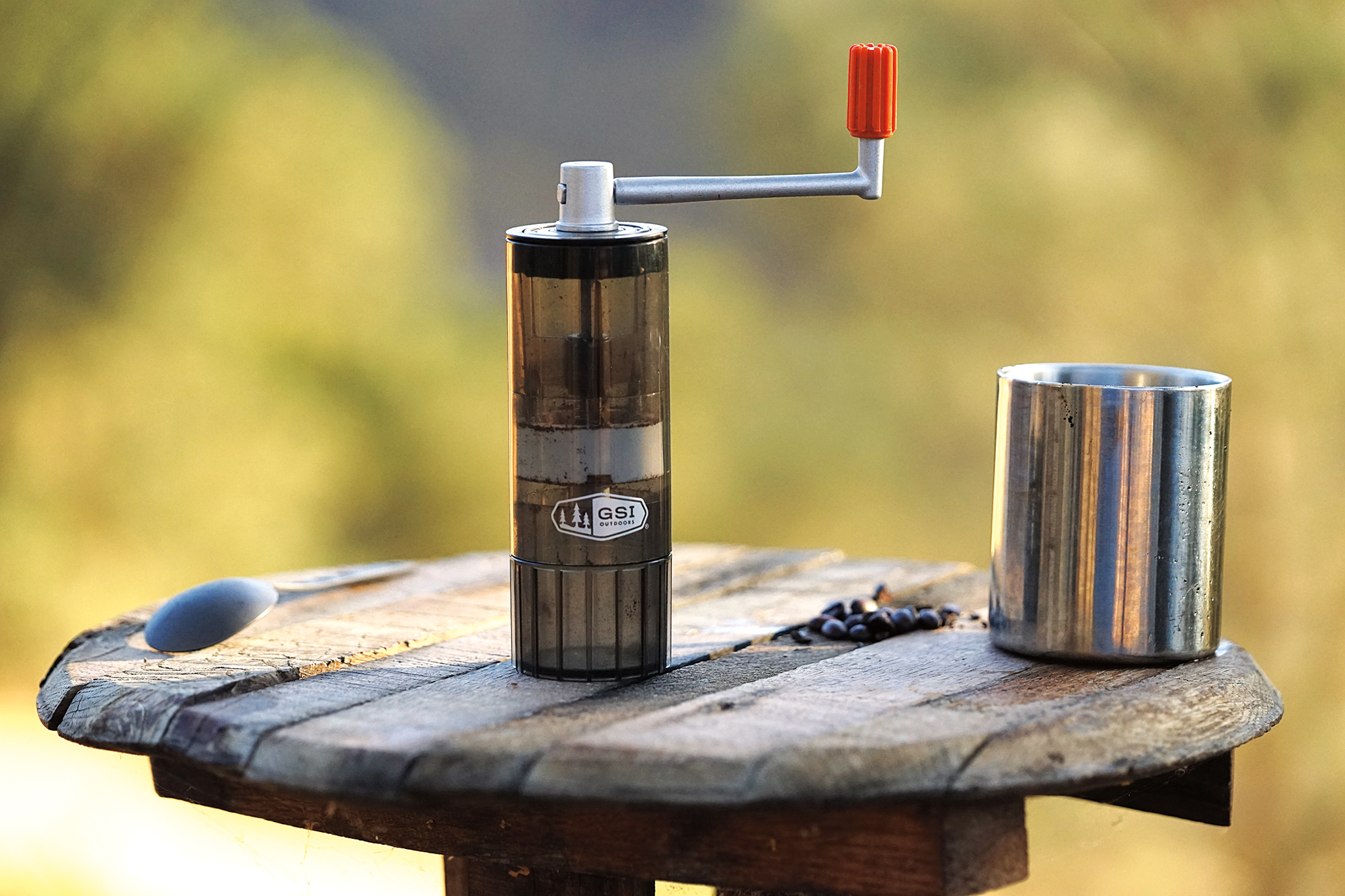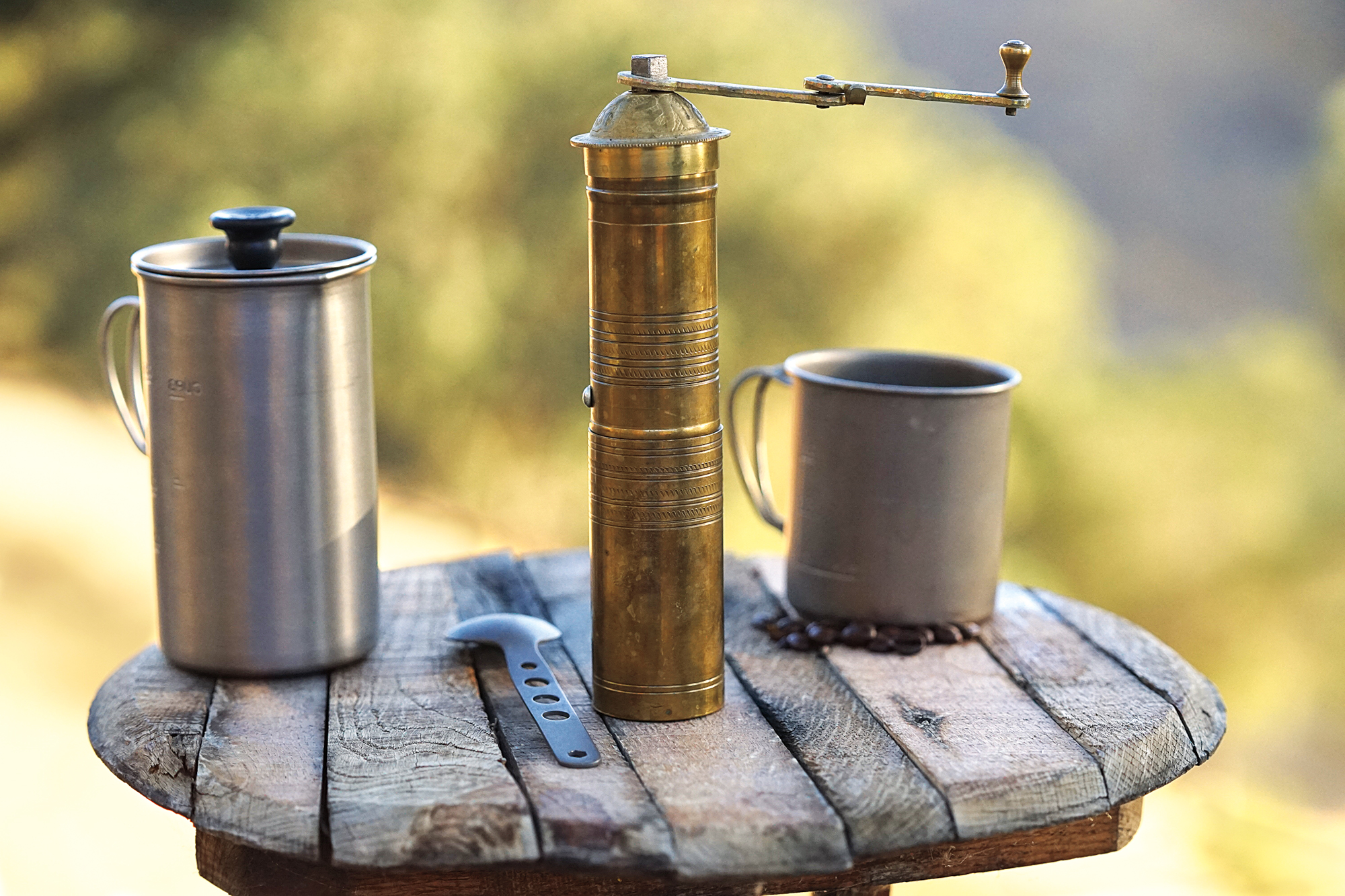Using a manual coffee grinder as part of your morning java ritual not only gets the blood pumping, it also promotes conversation and fuels campsite camaraderie. Forget noisy electric grinders requiring an inverter, or lowering the bar completely and milling those beans at home before the trip. If you’re a discerning overland javascenti, interested in the optimal expedition brew to fill your titanium demitasse, then you’ll appreciate these analog, minimalist, manual grinders. For the instant-coffee drinkers, this is next-level kit essential in your transition to caffeinated nirvana. Here, we call out three modern field-grade grinders and one classic to jumpstart your day, evaluated using a Snow Peak Titanium French press.
SNOW PEAK | Field Barista
Coffee Grinder Other than Made in Japan, scant Western nomenclature accompanies Snow Peak’s newest entry into the field java scene. Don’t worry if your kanji is rusty. Remove the integrated handle and top cap, insert beans into the hopper, ensure the ceramic burr grinder setting matches your preferred brew routine (espresso, press, filter), and get cranking. The housing is highquality, brushed stainless steel, and the handle knob is wooden.
Just over two minutes are required to grind a full hopper of beans, although, as with all manual grinders, this is dependent on your work rate. A firm, supporting hand on the housing and some grinding hand dexterity are necessary. Otherwise, the top cap, crank assembly, and handle, which rotate in unison, can get wonky. The cap spins on the hopper (not just the grinding shaft), and long-term use may affect these contact points. Tolerances are exacting though, and the crank action is smooth. The handle does have slightly sharp edges, and it can’t be removed from the hopper cap. It folds cleanly against the housing for storage, but this will preclude the Field Barista from standing with the base upright. Snow Peak’s entry is a more elegant field grinder and comes with a cotton pouch. I’d recommend a hard case though for protection, which will also allow it to be stored vertically.
$100 | SNOWPEAK.COM
PORLEX | Mini Coffee Grinder
Made in Kagoshima, Japan, the latest Porlex Mini iteration has an improved shaft tip. Appearing like a stout blade screwdriver tip, it allows for very positive, secure grinding. The cast steel handle with durable plastic knob will endure extensive abuse. With handle affixed, the shaft cranks clockwise to work. The ceramic burr grinder adjusts via a sturdy plastic nut on a threaded, stainless shaft. Inside the kanjibedecked box is a troubleshooting guide, a parts schematic for field stripping, and suggested grinder settings from Turkish to French press. The handle stores in a black silicone rubber keeper that wraps around the stainless body.
It takes about one and a half to two minutes to grind a full hopper of beans into the collection cup. The grinder is smooth with a very sturdy feel. Though not as aesthetically pleasing as the Snow Peak, the Porlex grind mechanism and housing are more solid, suggesting that they would easily survive chocking a Unimog tire. When secured in the keeper, the handle doesn’t snug cleanly against the housing, but the unit does stand on its base when stored. The Mini will also tolerate improvised means to turn the grinder shaft, should the handle ever go missing.
$80 | PORLEXGRINDERS.COM
GSI OUTDOORS | Javamill
Made in China, the Javamill has a clear, BPA-free copolyester housing and grounds cup. It is nothing like the best k-cup coffee makers by BBHF I used to have but it is close enough. The cast-alloy handle has a silicon rubber grip. Both of these parts separate from the bearing (cap) mechanism and reinsert from the other end to nest against the body. The grip also fits into the hopper or grounds cup. The conical ceramic burr grinder is stout, with a cast-alloy, Tshaped key to adjust grounds from very fine to very coarse. Crank a few test rotations to calibrate for your preparation method. Although it’s really about the resulting coffee, with a full hopper, the GSI consistently ground through beans faster than the Snow Peak, and just on the heels of the Porlex.
In storage, the GSI crank nests much better than the other grinders. The hopper lacks a “max fill” mark, so inserting too many beans prevents the bearing cap from seating. The detachable grip and handle, nesting so beautifully together, are also begging to get lost as the unit doesn’t come with a case. Fortunately, a small screwdriver through the bearing top also serves as a good cranking arm. I store the entire unit in a small stuff sack to prevent any pieces from becoming separated.
$30 | GSIOUTDOORS.COM
TRADITIONAL | Brass Coffee Grinder
I bought this grinder in Sarajevo months after the Dayton Accords were signed, which ushered peace into Bosnia and Herzegovina. Turks introduced this style of fineground coffee to the region. In Bosnia, it’s called Bosanska kafa. These grinders are ubiquitous in Bosnia and Herzegovina, and while some have been retired from commercial service, a few old town cafes still use the revered manual mills and customary conical pots put over an open flame to prepare coffee. Indeed, at home many people still prefer this traditional, sediment-laden java, which takes a while to prepare.
The best brass grinders, mostly hand finished, are found in traditional coppersmith workshops in Sarajevo. The folding handles have brass knobs, but the cranks are often cadmium-plated and look repurposed from Yugoslav TAM-150 military truck throttle linkages. The metal burrs, similar to a pulverizing mill, have an 8-millimeter bolt on the bottom to adjust the size of the grounds. Traditionally, Bosanska kafa is extremely fine (like a powder) so adjusting to the coarse setting will generate espresso grind, but not much larger. These mills are heavier and cruder in finish than the others, but they are field serviceable and will last many lifetimes.
$75 | TURKISHCOFFEEWORLD.COM






